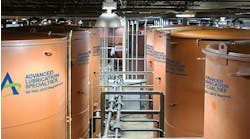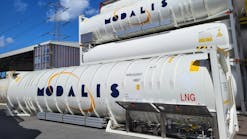Constitutional changes bringing opportunities for private investment in Mexico’s petroleum terminal sector
WITH Mexico’s domestic oil production and refining stagnating, the country is now importing more than half of the refined fuels it needs. Much of this imported fuel is being handled by private investors, who are involved in building new infrastructure to transport, store, and distribute the fuels.
A panel entitled “The New Frontier: Building and Operating Liquid Terminals in Mexico” reviewed some of the latest developments prompted by energy policy reform in Mexico over the past six years. The panel was part of the International Liquid Terminals Association’s 2018 International Operating Conference held in mid-June in Houston, Texas.
Panelists included Earl Crochet, director of engineering and operational optimization for Kinder Morgan Terminals; Fernando Pereira, business development manager for Grupo Lodemo and subsidiaries, including Hidrosur Energeticos; Robert Howse, director of estimating and engineering at Kiewit; and Allan Roach, senior vice-president for global strategy at Watco Companies.
They discussed two of the newest petroleum storage terminals that were built in Mexico with private investment. One facility is a marine terminal in Progreso, Yucatan, and the other is a unit-train terminal with storage tanks in San Luis Potosi.
It’s important to note that private investor involvement in Mexico’s energy sector was an unprecedented development that was made possible by changes in Mexico’s constitution in 2013. Under previous Mexico constitutional law, Petróleos Mexicanos (Pemex) was the state-owned petroleum monopoly controlling all petroleum industry resources and facilities throughout the country.
Pemex monopoly
Pemex held that state monopoly for 76 years, during which Mexico grew into the world’s largest oil exporter. However, oil production peaked at 3.4 million barrels a day and now stands at around two million barrels a day. The country is now the world’s 15th largest oil producer.
In an effort to halt the decline, outgoing Mexico President Enrique Peña Nieto launched an ambitious energy reform effort that included constitutional reform and new laws allowing international oil companies to drill for oil in Mexico for the first time in 76 years. The laws enacted in 2013 also enable private investors—domestic and foreign—to develop energy sector projects, including storage terminals.
The constitutional changes were opposed by Mexico’s newly elected President—Andrés Manuel López Obrador. Despite that opposition, López Obrador—who takes office December 1—has indicated that he will not arbitrarily reverse Mexico’s energy reforms, a process that would be difficult, but not impossible. In addition, he recently sent a letter to US President Donald Trump, calling for an end to the North American Free Trade Agreement trade talks that have dragged on for months. López Obrador has said those negotiations are damaging economic confidence in Mexico.
“Newly elected President López Obrador needs the continued private investment in petroleum terminal infrastructure,” said Grupo Lodemo’s Pereira. “He has said he wants a stable and prosperous Mexican economy. Reversing energy reform would hurt Mexico’s overall economy and would chase away foreign investors from across all industries.
“President López Obrador has said he wants lower fuel prices. That can’t be done without a more efficient fuel storage and distribution infrastructure. Pemex lost a massive amount of money last year. It’s not practical to keep subsidizing the government-controlled oil industry. The government needs private investors in this industry.”
Critical justifications
In his ILTA presentation, Pereira listed seven critical justifications for energy reform in Mexico: Declining oil and gas production, increasing power production costs, stagnant investment in renewables, aging energy sector infrastructure and limited investment for upkeep and expansion, limited technological development, a widening human resources gap, and increasing dependency on natural gas and oil products imports.
On the infrastructure side, various studies document the growing shortage in storage capacity for fuels in Mexico. Just 73 Pemex terminals (with a total capacity of 14.6 million barrels in 583 tanks) account for virtually all of the fuel storage capacity in the country.
“Together, these terminals have just 11 days of operational capacity,” Pereira said. “In contrast, the United States has a 27-day reserve of refined fuels in storage terminals; the United Kingdom has a 31-day reserve; and Italy has a 56-day reserve. Mexico has now set a target of five days refined fuel inventory in each of its regions by 2020; and that will rise incrementally to at least 10 to 11 days minimum inventory reserve in most regions by 2025.”
In addition, the storage capacity is not efficiently distributed across Mexico. The current storage terminal infrastructure is insufficient to meet the growing need to handle imported refined fuels. Expanding beyond storage terminals, Pereira cited other infrastructure weaknesses, including rail networks, pipelines, and more.
Ample opportunities
All of this brings plenty of opportunity for the private sector, and companies like Grupo Lodemo/Hidrosur have launched innovative projects to fill some of the most critical gaps in Mexico’s fuel storage and distribution system.
“Our Hidrosur investors are a group of gas station owners that live with the day-to-day constraints of a regulated system that is thoroughly past its capacity,” Pereira said. “They saw the need for more terminal infrastructure a long time ago and acted as soon as they had the opportunity.
“With their backing, we are building the first marine storage terminal for refined fuels in Mexico financed by private capital. This was an opportunity provided by the energy reform now underway in Mexico.”
Robert Howse with Kiewit described the effort that went into development and construction of the Hidrosur refined fuels terminal in the Port of Progreso. Currently coming online, the terminal was financed with an investment of approximately $60 million and includes five storage tanks with a total capacity of 485,000 barrels that are designed to hold gasoline, diesel, and aviation fuel.
“We certainly faced some challenges, starting with new regulations, standards, and policies that were rolled out with the energy reform over the past three years,” Howse said. “Many of the new regulations still have not been finalized, and revised regulations were announced midway through our project.
“These regulations are so new that many have not yet been challenged. We don’t know how strictly they will be enforced or whether they will be fully implemented.”
Man-made island
One of the requirements for the Hidrosur terminal is that the operation must have the capability to be demobilized within 24 hours if ordered by Mexico’s government. The terminal occupies a leased four-hectare (9.8-acre) site on a man-made island at the Port of Progreso.
“The government owns the site, and we have to be able to completely shut down our operation if government needs the location,” Howse said. “This was the last property concession on the island, and it is the ideal location for handling in-bound shipments of refined fuels in marine tankers.
“Another challenge is the seven-kilometer (4.3-mile) single-lane causeway that connects the terminal site to the mainland. All of our customer shipments are by tank transport. We have to maintain tight control over the in-bound trucks, and we must be able to load a transport within 30 minutes of its arrival.”
Mexico has not seen this sort of construction boom in many decades. It has been more than 30 years since large new storage terminals were being built.
The downside of that is a nationwide shortage of skills and technology to build the sort of new storage terminals that are needed. The Kiewit project team had to bring in the specialized fabrication equipment needed in construction of the storage tanks.
“Mexico does not have the capability to roll large sections of steel plate for the storage tanks,” Howse said. “We also had to bring from the United States trainers and supervisors with welding expertise. We brought automated welding equipment including track welders and track gougers.
“Taking those steps, boosted the output of our welders from about 10 feet a day to nearly 100 feet a day during the erection of the storage tanks.”
Unit trains
In other parts of Mexico, refined fuel imports are arriving from US refineries by unit trains. Watco’s Roach described the unit-train terminal his company is constructing in partnership with Grupo Valoran and the Kansas City Southern de Mexico railroad. The terminal commenced fuel transload operations in October 2017.
The terminal is sited on property in the World Trade Center industrial park near San Luis Potosi, roughly in the center of Mexico. The unit-train terminal is handling gasoline, diesel, and LP-gas. Customers include Exxon Mobil, which has begun opening retail gas stations in Mexico.
“WTC Industrial has an existing, modern, state-of-the-art industrial park,” Roach said. “This is a strategic location. We’re on the KCSM main line that connects us to US refineries along the Texas Gulf Coast. We also have direct rail access to the Mexican ports of Tampico and Altamira. Running beneath the industrial park is a major Pemex pipeline that could become an injection point for shipping refined fuels to the southern part of the country.
“The location adjacent to the KCSM main line ensures easy access to the terminal and quick cycle times of customer rail cars. The terminal is located in a Free Trade Zone, which provides an added economical advantage to rail shippers. The terminal will have 24 hour/7 days a week secured, fully automated operations for unit trains and manifest shipments.”
The project consists of two phases, the first of which has been completed. During Phase I, roughly 150,000 cubic yards of dirt was removed to prepare for the project. The build entailed two 10,000 feet long R&D tracks, a 12-ft roadway along each side for train inspection, three trans- load tracks at 40 cars each, two mainline switches in the KCSM mainline, an engine track, a bad order track, two new security buildings for the entrances, and 17,000 feet of 8-ft-high hurricane fence with razor wire top and bottom.
“In all, we constructed seven and a half miles of track for the project,” Roach said. “The facility is designed to unload unit trains—94 tankcars carrying 68,000 barrels of product—in 24 hours.
“We currently have portable platforms for transloading product directly from tankcars into tank transports. These platforms are equipped to inject customer additives directly into the product during transloading. Our goal is to turn a fuel transport every 30 minutes, but 45 minutes is typical right now. Most of the road transports we are handling in Mexico are doubles trains.
“It is a process that is working very well, and we plan to keep the transload platforms even after permanent tankcar unloading stations are in place. We have smaller customers who like the flexibility of the transload platforms.”
Phase II is now underway and consists of adding three 150,000-barrel storage tanks for refined products, up to 10 truck loading racks with additive injection and blending capabilities, two fire water tanks for the fire system, an office building with secure entrances, team member card access, and a secure control room. Part of Phase II will see the addition of an on-site quality control testing lab operated by an independent testing company.
“Our facility currently is permitted for 600,000 barrels of storage, but we have enough property for upwards of a million gallons of storage,” Roach said. “That is way more capacity than is needed to serve the surrounding area.”
Roach also provided a brief review of other refined fuels unit-train terminals that are being constructed or are under consideration. In addition to the KCSM, Grupo Valoran, and Watco location in San Luis Potosi, Grupo Simsa has opened a terminal in San Jose Iturbide, Guanajuato.
Projects are underway by KCSM and Bulkmatic Transport in Salinas Victoria, Nuevo Leon; Ferropuerto Midstream in Aguascalientes; USD Group and Savage Companies in Queretaro; Protamsa in Tampico, Tamaulipas; High Level Energy in Coatzacoalcos, Veracruz; and Grupo Nex-X in Mexico City. Valero has terminals planned in Altamira, Tamaulipas, and Veracruz. Rail terminals with tank storage also are under consideration for Torreon, Coahuila; Chuihuahua; Mazatlan, Sinaloa; Manzanillo, Colima; and Guadalajara, Jalisco.












